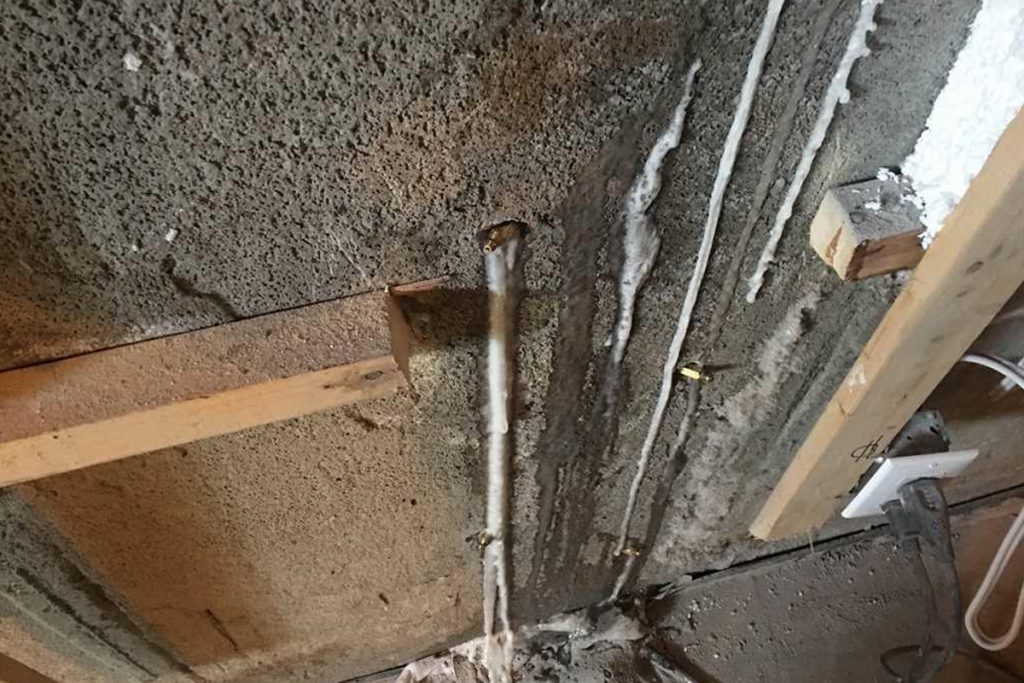The popularity of polyurethane crack injection
Polyurethane crack injection is without a doubt the most common waterstopping foundation crack repair method in use throughout the world. This widespread use of polyurethane, sometimes referred to as urethane or grout, for concrete crack injection is a tribute to the inherent versatility of polyurethane in waterstopping applications. Foundation crack injection is commonly used in both residential (basement waterproofing) and commercial applications (parking garages).
This is a picture of a polyurethane resin injection of a residential foundation crack. As no excavation is required, the cost of this type of waterproofing repair is 1/3 of the cost of excavating the foundation and waterproofing the crack from the outside. The pressurized injection will fill the crack through the entire thickness of the foundation wall, keeping water outside the building envelope where it belongs.
There are numerous applications for polyurethane injection in commercial applications. In this picture, a crack in a very high poured concrete slab is being injected so that water on the factory floor above cannot leak onto the level below.
Properties of polyurethane resin
Polyurethane is a fluid resin which is injected into concrete cracks, rock fissures, expansion joints and other voids in solid underground structures. When used in concrete crack injection applications the polyurethane is injected into a crack; within minutes the polyurethane undergoes a chemical transformation from a liquid to a solid.
The versatility, and consequently the popularity, of polyurethane resins for injection applications stems from polyurethane’s properties:
- It has a very short cure time, making it ideal for urgent waterstopping;
- The resin cures normally whether a foundation crack is wet, actively leaking, or dry;
- There are literally thousands of polyurethane resin formulations which is useful when repairing foundation cracks because the viscosity of the resin and cure time can be controlled; and
- Polyurethane, once cured, can be quite flexible depending on the formulation.
Polyurethane crack injection in residential applications
Injection waterproofing is commonly used in residential basement waterproofing applications primarily because it is far less expensive than excavating a foundation and waterproofing the exterior foundation wall, and it is a very reliable waterstopping crack repair when done properly.
The importance of hiring a skilled contractor for polyurethane injection
While the polyurethane injection process is simple in principle, most people (including waterproofers) do not appreciate the skill and aptitude that a contractor must have to successfully perform a polyurethane crack injection. In general, the crack injection process usually requires some amount of tweaking based on the characteristics of the crack under repair. Without a comprehensive understanding of the conditions that have to be met in order to successfully inject a crack, a technician will not be able to ensure that the crack repair will be long lasting. Furthermore, a substantial amount of tenacity and attention to detail are required in order to do a good job.
Why polyurethane crack injections are recommended over an epoxy crack injections
When speaking with sales representatives from basement waterproofing companies many homeowners are told that polyurethane crack injections are superior to epoxy crack injections because cured polyurethane is flexible and epoxy is not. It is true that polyurethane is flexible while epoxy isn’t; however, the desirability for flexibility in an injected resin is not a given. This begs the question, since poured concrete is extremely rigid, why is it so important for an injected resin to be flexible? After all, a poured concrete foundation is unyielding except when it cracks.
It is our view that many waterproofing contractors promote polyurethane crack injection repairs over epoxy crack injections because they do not offer both injection services. For a comparison of the two injection methods click on the following hyperlink: epoxy vs polyurethane.
How a polyurethane crack injection is done
Check out this video to view a polyurethane crack injection in progress:
